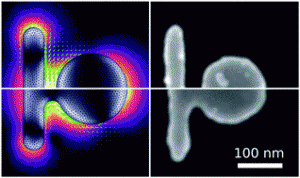Modeling and characterizing surface plasmon mode hybridizations in connected and disconnected metal nanostructures
When a metallic object of nanometric size is irradiated by light, the incident electric field can make the electrons of the metal oscillate coherently. These nanostructures, called plasmonic, are studied to increase the sensitivity of biosensors or the efficiency of solar cells. They present wide (« bright ») or narrow (« dark ») resonances, which can be tuned in frequency by playing on their shape and dimensions. Thus, by bringing together a metallic nano-disk and a nano-stick, we obtain weak couplings between these oscillators, or even hybridizations for sufficiently short distances. The case of a coupling by direct metallic contact has however been less explored and gives rise to specific effects. Their understanding is important for applications in nanoscale detection.

Left: amplitude of the electric field (color) and surface charges (gray) for the low frequency quasi-normal modes of the disconnected (top) and connected (bottom) structures. Right: SEM image of the lithographed nanostructures
Summary of the work done in the framework of the ANR « Tiptop » and the thesis of Damien Eschimèse at IEMN
We have numerically and experimentally explored the formation of hybrid modes between a nano-disk and a nano-stick of gold, separated by an air gap of a few tens of nanometers or connected by a metallic connection. Numerical simulations were performed by finite elements using open-source programs (FreFem++, Gmsh). We combined simulation of extinction, scattering and absorption spectra under plane wave illumination and calculation of quasi-normal modes. The latter approach gives access to complex frequencies and mode shapes independently of any illumination, thus facilitating the analysis of coupling and hybridization effects of modes. Finally, a simplified analytical model of coupled oscillators was used to verify the consistency of the methodology.
We have shown that coupled and disconnected structures have very different plasmonic properties, especially in the case of longitudinal polarization for which the metallic connection redistributes surface charges in the vicinity of the gap. Experimentally, the obtaining of connected or disconnected structures depends on the importance of the proximity effects, inherent to the top-down lithography method. Dose control allows to obtain structures physically separated by a gap of 20 nm, or connected by a connection of similar width. A very good agreement has been obtained between simulations and experimental measurements, both on connected and disconnected structures. We have shown that the transition between weak coupling (without hybridization) and strong coupling (with hybridization) is obtained for a gap of the order of 40-50 nm in the disconnected structures and for short rods, whereas the presence of a metallic connection always leads to strong coupling whatever the length of the rod. In the latter case, the « diabatic » modes, i.e. non-hybridized, are themselves modified by the metallic connection, the bright mode being narrower and the dark mode wider. The methods and results presented in this work can be adapted to a large number of systems, in particular for the realization of biosensors or nano stress sensors.
« Strong and weak polarization-dependent interactions in connected and disconnected plasmonic nanostructures », Damien Eschimèse, François Vaurette, Céline Ha, Steve Arscott, Thierry Mélin and Gaëtan Lévêque, Nanoscale Advances, 4, 1173, 2022.
DOI: 10.1039/d1na00620g














